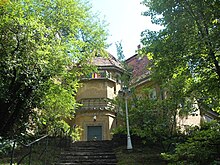The Buddhist house
The Buddhist House is a Buddhist temple complex or Vihara in Berlin and is considered the oldest Buddhist temple in Europe.
history
The builder of the Buddhist house was the doctor and writer Paul Dahlke , who ran a practice in Berlin and got to know Buddhism on his trips to Asia . In 1900 he became a Buddhist himself and a teacher of this religion, translated a number of old Buddhist writings from the ancient Indian Pali language into German and published the New Buddhist magazine .
Shortly after the end of the First World War , a favorable opportunity arose for him to acquire a pine-covered heather area of around 36,500 m² in Berlin-Frohnau . As a center for the Buddhist religion, he had the villa-like house built there from 1923 by the Pankow architect Max Meyer with the Japanese-style temple building behind it. Dahlke financed the construction through generous donations, but also through its own funds. He planned the outdoor facilities himself based on his interpretations of Buddhist teachings. In August 1924, the construction of the "Buddhist House" had progressed so far that Dahlke could move into it with his housekeeper and some Buddhist friends. Another temple was built in 1926.
The "Buddhist House" was intended as a place for inner purification, as far as this can be achieved in a compromise between life as a Buddhist monk and Western conditions. It could not be a monastery because the material and spiritual conditions were insufficient. Instead, it was a middle ground solution between a monastery and a place to stay for lay people. The “five rules” were the minimum requirement for the behavior of those living here.
The " German Dharmaduta Society " (GDS), founded on September 21, 1952 by Asoka Weeraratna, acquired the property from Paul Dahlke's heirs in 1957 and transformed it into a Buddhist vihara with monks from Sri Lanka and others living in it Countries were posted.
present
Since 2000 the house has been managed by Tissa Weeraratna, a nephew of the founder of the “German Dharmaduta Society”. In the summer of 2005, the new administrator released the monks and employees who had previously worked there in order to run the house on his own. He is supported in this by the German association of the house, which was founded in 2007.
In the past, internationally respected Buddhist monks lived and worked in the Buddhist house. They were all committed to the monastic ideal lived by Asoka Weeraratna and to Theravada Buddhism, which today u. a. is the state religion in Sri Lanka, Thailand and Burma. There were also prominent visitors again and again, most recently on February 2, 2007, when the Sri Lankan Foreign Minister, Rohitha Bogollagama, who had been elected to office shortly before, visited the house.
After serious irregularities in the management, the umbrella organization of Buddhists living in Germany, the "German Buddhist Union", was forced in 2009 to exclude the Buddhist House from the group of institutions that represent Buddhism in Germany. Since then, the facility has been primarily a tourist attraction and memorial in the north of the German capital. External teachers continue to give lectures and meditation courses. In addition, the Sri Lankan monks living in the house are the contact persons for the Sinhalese community in Berlin. The library and the meditation room are available to all visitors.
The archives of the house were viewed in 2019 by Gerdien Jonker and partially systematized.
architecture
You enter the property through the elephant gate, which is modeled on a Ceylonese building. In front of it a steep staircase with 73 steps leads up, which symbolizes the noble eightfold path of Buddha to redemption from the suffering of impermanence. Behind the house there is a meeting place and the "deepening pond", a facility that symbolizes the practitioner's four sinkings until the state of being free from happiness and suffering is established. There is an extensive library in the house. The Ceylon House, which was converted from an outbuilding in 1974 into a guest house, stands a little apart. A stone sculpture of the goddess of mercy, Kannon ( Guanyin ) , donated by the Japanese city of Nagoya in 1959, can be seen in the garden . Dahlke was buried at an unknown location in the garden; In 1988 a plaque was placed on the entrance gate in honor of his honor.
"The Buddhist House" is now a national cultural asset and is a listed building . In addition, the green areas at the “Buddhist House” are listed as a garden monument .
Individual evidence
- ↑ Martin Baumann: Helmut Klar - contemporary witness on the history of Buddhism in Germany 1995, pp. 39–46.
- ^ Gerdien Jonker: The archive of the Buddhist house in Berlin-Frohnau . In: MIDA Archival Reflexicon . 2019, p. 1–9 ( projekt-mida.de ).
- ↑ image of Kannon statue das-buddhistische-haus.de, access August 13, 2014
Web links
- The Buddhist house
- Buddhist House Förderverein e. V.
- 360 ° panoramas from the Buddhist house
- Contribution to the exclusion of the Buddhist House from the DBU
- Entries in the Berlin State Monument List: Buddhist house ,Green areas of the Buddhist house
Coordinates: 52 ° 38 ′ 9 ″ N , 13 ° 18 ′ 10 ″ E

